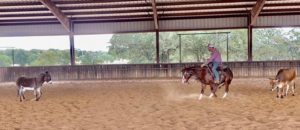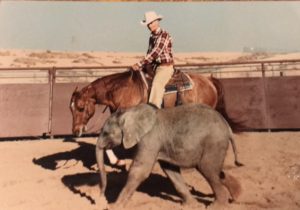
Dustin Gay Working a Donkey
Think a bull-headed brahman is intimidating to cut? Then imagine going eye-to-eye with an elephant! Yes, an actual elephant. That is what one enterprising cutter did to solve his cattle crisis.
In fact, cutters around the world are finding creative solutions to their lack of cows that includes an eclectic mix of animals from donkeys, water buffalo and llamas to yes, even elephants.
Cutting horse trainer Dustin Gay bought donkeys to help halter break his horses. One day the cows were not cooperating. His wife was joking about working the donkeys and Gay decided it couldn’t be as bad as the cows he had in the arena.
“I turned one in and it was awesome! It acted like a fresh cow. The horses didn’t seem to mind it all. If anything, it got their ears perked up and more intense,” he said.
He only had five donkeys and lots of horses to work so they did not last long. He said they would be good to work again if they got a good break.
In Aubrey, Texas, Non-Pro Lori Winchester has made llamas part of her program for some time.
“They are very fast. When they stop and turn, they throw their heads down which will get those older horses really swoopy and snakey…They run fast and stop hard,” she said.

Jim Halligan working a Barbados Sheep
According to Winchester, the llamas lasted a long time but when they were done, they were done. She said the minute they got sour, they let you know it and would start striking.
She said the horses were scared of them at first but a friend brought them over and said if you can cut them you can handle any wild cow.
Non-Pro Jim Halligan has always raised and trained his own cutting horses. When a drought struck Zell, South Dakota in 1986 he and his wife Barb sold their cows and bought Barbados Black Belly Sheep. Halligan said other breeds of sheep would probably work but the Barbados Sheep are what was available to him.
“My brother Frank had seen somebody working sheep and my other brother, Bill who trained Border Collies, knew where a trailer load of them were for sale. We purchased them and have raised lambs to work ever since,” Halligan said.
Halligan starts working the sheep at about a year old. He can work each one about 50-100 times per year as long as they are not worked until they stop. He said they have even had some last for 12 years. Many of the sheep enjoy playing with the horse, he said.
If you pay attention to the way the sheep want to work and let them move the way they want, he said they can last a long time. He can pick out a certain sheep to work based on what he wants to work on with his horses.
“We use the sheep in a training situation. One sheep in a round pen. The sheep are quicker than a cow. They stop on their hind end the way I like a horse to stop and I think your horses mimic that,” Halligan said.

Colin Clancy’s Water Buffalo
Halligan has a square pen with the corners blocked off with gated panels to round the corner. He puts the herd of sheep behind the panel and works one at a time in the arena. He switches up where he lets the sheep out and puts them in different corners to keep them wondering where they are going next. He said it helps keep them moving around the arena.
There is still a need to actually work cows because working sheep out of a herd doesn’t go well. The horse needs that out-of-the-herd experience so he will work cattle. He also added that when working sheep there isn’t a need for turn back riders so he must make sure that horse has been in the arena with turn back help.
Non-pro Colin Clancy trains cutting horses in Queensland, Australia and he works water buffalo known as Northern Territory Feral Buffalo. He had heard of some fellow cutters that worked them and decided to see if they would fit his own program. He said that the water buffalo are very similar to cattle but they tire faster. However they can handle being worked more often overall.

Bob Norris working Amy the Elephant calf
They are better suited to the hot conditions in Australia than Bison. He likes to use them for starting two year olds or for quick works. They’re very smart so they lose their feel and reactiveness but they are a valuable addition to his program.
The late Robert Norris, from Colorado Springs, Colorado was a philanthropist, rancher, and quarter horse breeder under the well known Tee Cross brand. He was also the original Marlboro man, starring in the cigarette brand’s iconic ads. Norris was known for his generosity and in the late 80s, he leased stalls out to an elephant owner, who rescued baby elephants that had been abandoned in Zimbabwe and brought them to the United States.
His children couldn’t resist the elephant calf so Norris adopted one. He hand fed the calf they called Amy. As a cutter and rancher used to training animals, Norris was curious about Amy’s abilities and he worked one of his cutting horses on the baby elephant. It may not have been a regular part of his program but it was so successful and quirky that the NCHA featured the story in the Chatter some decades ago featuring the photo below.